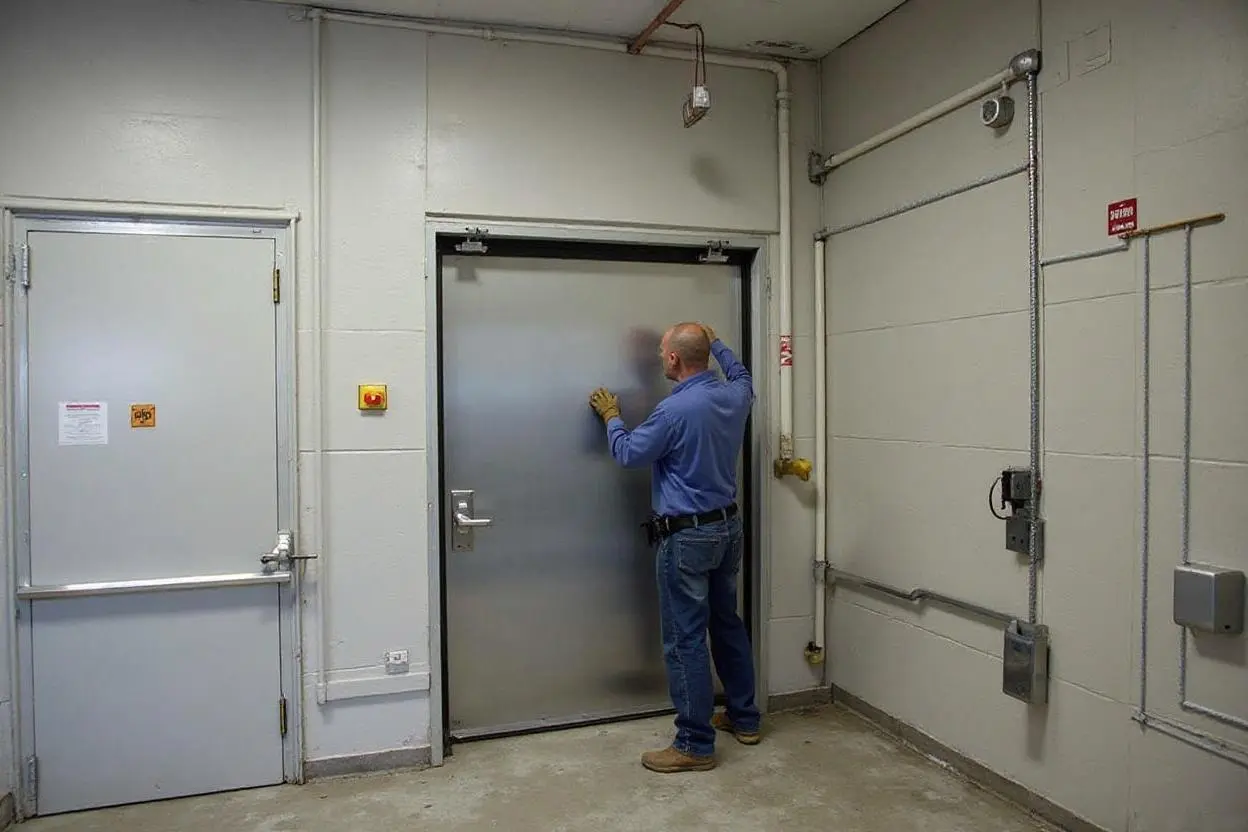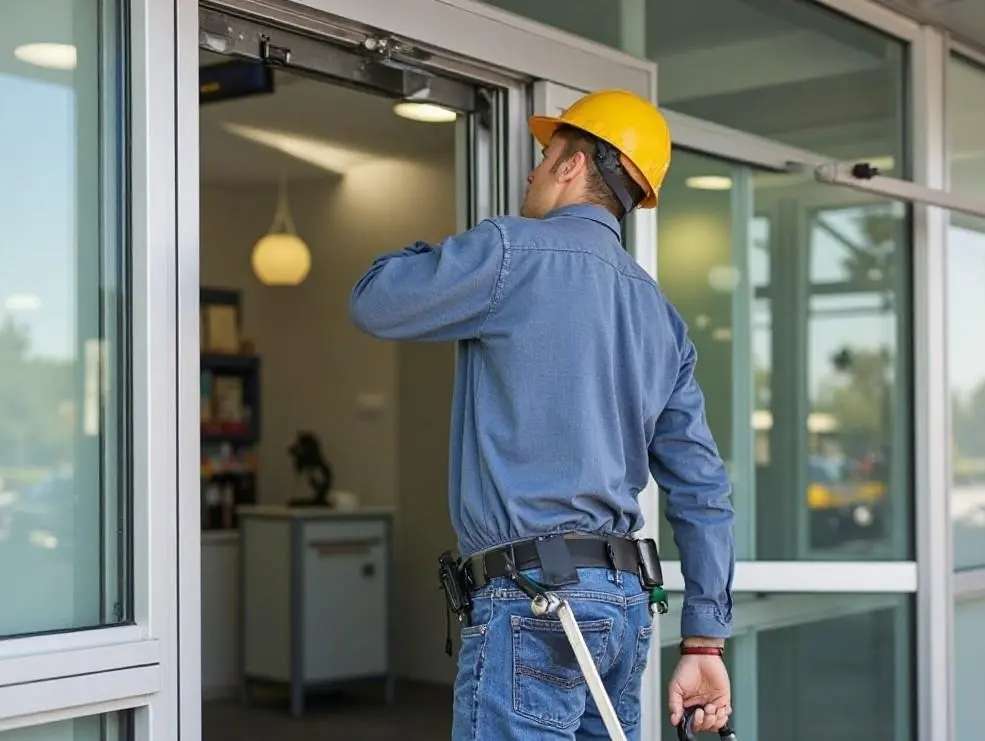
Top 7 Reasons Automatic Sliding Doors Break Down in Buffalo Businesses
Automatic sliding doors work hard in Buffalo. They face lake-effect snow, wind gusts, salt, and heavy foot traffic from morning rush to Sabres game nights. When they fail, the impact is immediate: customer frustration, ADA access risks, energy loss, and safety concerns. Based on years of field calls across Downtown, Elmwood Village, Tonawanda, Cheektowaga, and Amherst, here are the most common reasons these doors fail—and how to prevent costly downtime.
Weather that never takes a day off
Buffalo winters punish sensors, belts, rollers, and control boards. Wind drives moisture into header cabinets. Freeze-thaw cycles create condensation that corrodes connectors and clogs tracks with ice. Salt dragged in from sidewalks grinds into rollers and thresholds. In spring, that salt residue continues to chew through metal parts.
Shops along Niagara Street and Main Street see this pattern the most because wind funnels down long corridors. Facilities can reduce failures by scheduling a quick mid-winter inspection to re-grease rollers with cold-rated lubricant, clear weep holes, and check weatherstripping. A 20-minute service often avoids a stuck door on a 10-degree morning.
Dirty or misaligned sensors
Motion sensors and presence sensors prevent strikes and control open times. They fail in two predictable ways: the lens gets cloudy from dust and salt spray, or the unit gets bumped out of alignment by carts and deliveries. The result is slow response, ghost openings, or a door that never closes.
In grocery vestibules and busy clinics on Delaware Avenue, lens cleaning every two weeks makes a difference. So does checking the detection zone after a reset. If the sensor cannot see the threshold because of glare from snow or low winter sun, the controller will default to a safe-but-open state, bleeding heat. Adjusting the detection field and tilt angle fixes most of these service calls.
Worn belts, frayed cables, and tired rollers
Drive belts stretch. Cables fray. Rollers flatten into slight ovals under constant load. These parts do not fail all at once; they create clues: a chirp on startup, a shudder near full close, or a door that drifts out of sync. Buildings with steady traffic—think pharmacies on Hertel and medical offices near Buffalo General—reach these wear limits faster than low-traffic sites.
Experienced techs measure belt tension, inspect roller bearings, and check end stops for impact marks. Replacement often costs less than the energy lost from slow, incomplete closes. On average, high-traffic doors need rollers and belts every 2 to 4 years in Buffalo’s conditions.
Poor track hygiene and threshold damage
Grit, salt, and tiny stones work into the bottom track. They score the running surface and block smooth travel. In winter, slush melts and refreezes overnight, locking a door panel until morning sun. Threshold heaters help, but only if they work and the wiring hasn’t corroded.
Maintenance staff should vacuum the track daily on heavy snow days and weekly otherwise. For plazas in West Seneca and Williamsville, A-24 Hour Door National Inc often installs brush kits and upgraded end caps that shed grit better than factory parts. If the track lip is bent by pallet jacks, a precision straightening or track section replacement restores quiet, consistent Buffalo, NY movement.

Power and control issues
Automatic doors rely on clean power and correct grounding. Surges during summer storms or winter outages can damage control boards and input modules. Loose neutrals, shared circuits with refrigeration equipment, or DIY wiring changes often show up as intermittent faults.
Restaurants and convenience stores on shared strips see this frequently. A dedicated, properly grounded circuit reduces nuisance resets. Surge protection in the header cabinet protects the controller. If the door begins rebooting during compressor cycles, an electrician should review the panel while a door tech confirms controller health with diagnostic codes.
Outdated safety settings and bad compliance habits
ANSI/BHMA A156.10 and A156.38 standards define safe detection zones, approach speeds, closing forces, and hold-open times. Over years, parameters drift after repairs or upgrades. Sites that swapped mats for overhead sensors sometimes keep legacy settings that don’t match the new hardware. That creates hazards and legal exposure.
A quick compliance check catches stale settings: confirm opening speed, closing speed, and time-out. Verify presence detection on both sides and along the threshold. In mixed-use buildings in Allentown and North Buffalo, varied user profiles—strollers, walkers, mobility devices—make correct settings crucial. A-24 Hour Door National Inc documents these adjustments to protect property managers and reduce risk.
Human impacts: carts, ladders, and forced moves
Many breakdowns trace back to a moment: a ladder toppled into the panel, a vendor wedged the door open, or a delivery pushed a loaded cart across the threshold track. These incidents bend hangers, tweak end stops, and knock belt timing out by a tooth. Doors may still move, but the controller compensates until it cannot.
Training staff matters. Post a simple rule at the service entrance: no forced movement of panels, no tape over sensors, no prying the door during a power outage. Call for help instead. A field anecdote from a Broadway Market stall: a single taped-over presence sensor to stop “false opens” led to a strike injury during a rush. Removing the tape and adjusting the detection angle solved the root issue in minutes.
How Buffalo businesses spot trouble early
The most expensive calls follow weeks of small warnings. Teams that catch these signs avoid emergency shut-downs and lost customers.
- Intermittent hesitation at the first open in the morning
- New grinding, chirping, or clicking sounds near full close
- Doors that stay open longer on windy days without wind compensation set
- Sensors that flash status LEDs inconsistently or go dark
- Rising energy bills tied to doors failing to fully close
If two or more of these show up, schedule automatic sliding doors repair in Buffalo before the next weather swing. Quick intervention usually means adjustments and minor parts, not a full-header rebuild.
Seasonal service that actually works here
A maintenance plan should match Buffalo’s calendar. Fall service prepares for cold, salt, and wind. Late-winter service clears corrosion and resets sensors for bright spring light. Summer checks handle storm surge protection and high interior humidity.
A practical cadence for high-traffic sites:
- Fall: belts and rollers inspection, track deep clean, weatherstrip check, surge protection test
- Late winter: sensor cleaning and re-aim, threshold heater test, condensation drain clear These two visits cover most failure patterns seen from Kenmore to Orchard Park.
Why prompt repair pays off
A misaligned sensor or stretched belt adds seconds to each cycle. In a supermarket vestibule with 1,200 opens a day, that can hold a panel open for 20 to 40 extra minutes daily, dumping conditioned air. At winter gas rates, that waste often exceeds the cost of a service call within a month. More important, ADA access relies on consistent performance. A sticky panel can block a mobility device or create a bottleneck that frustrates customers.
Property managers near the Medical Campus report higher tenant satisfaction when doors open cleanly and quietly. That kind of small reliability shapes first impressions more than signage updates or fresh paint.
What a proper diagnostic visit includes
A good automatic sliding door repair in Buffalo follows a sequence that respects weather and usage:
A technician observes at least 10 cycles under real traffic, checks controller error logs, tests all safety zones with a cane or test object, measures belt deflection, inspects rollers and hangers, verifies track smoothness, confirms wind compensation and hold-open settings, and validates power quality and ground. Only then should they replace parts or change software parameters. This prevents “band-aid” fixes that create new issues.

A-24 Hour Door National Inc: local, fast, and practical
The team lives this work in Buffalo weather. Trucks stock cold-rated lubricants, common roller kits, belts for major brands, and surge protectors. Technicians service doors in hospitals on High Street, retail on Elmwood and Transit, and industrial sites in Lackawanna. Most same-day calls finish in one visit because the right parts and tools are on board.
For managers searching automatic sliding doors repair Buffalo, the process is simple: call or request service online, share the brand and header height, describe the symptoms, and note any recent power events. A dispatcher will schedule the nearest tech, often within hours. Transparent pricing, clear findings, and practical fixes—no upsell for parts you do not need.
Ready to keep your doors moving
If a door hesitates, hums, or stays open longer than it should, it will not get better by itself. Book an inspection before the next lake-effect system rolls through. A-24 Hour Door National Inc can stabilize the door today and set up the seasonal maintenance that fits your site and traffic. Service is available across Buffalo, Cheektowaga, Amherst, Tonawanda, West Seneca, Williamsville, and nearby suburbs.
Request automatic sliding doors repair in Buffalo now. Keep customers moving, keep heat in, and keep the building compliant—no surprises when the weather changes.
A-24 Hour Door National Inc provides commercial and residential door repair in Buffalo, NY. Our technicians service and replace a wide range of entry systems, including automatic business doors, hollow metal frames, storefront entrances, fire-rated steel and wood doors, and both sectional and rolling steel garage doors. We’re available 24/7, including holidays, to deliver emergency repairs and keep your property secure. Our service trucks arrive fully stocked with hardware, tools, and replacement parts to minimize downtime and restore safe, reliable access. Whether you need a new door installed or fast repair to get your business back up and running, our team is ready to help. A-24 Hour Door National Inc
344 Sycamore St Phone: (716) 894-2000 Website: https://a24hour.biz/buffalo
Instagram: @a24hourdoor
Buffalo,
NY
14204,
USA
Facebook: 24 Hour Door
Yelp: A-24 Hour Door National (Buffalo)
X (Twitter): @a24hrdoor